Laboratory Equipment Safety Labels
Some lab safety policies require that you post laboratory equipment to inform personnel of specific hazard information relating to the use of the equipment.
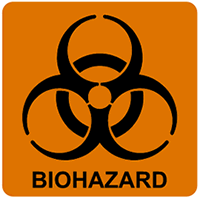 Biohazard (2.75″ X 2.75″)
Biohazard (2.75″ X 2.75″)- The biological hazard (BIOHAZARD) symbol be used to signify the actual or potential presence of a biohazard and to identify equipment, containers, rooms, materials or combinations thereof which contain or are contaminated with viable hazardous agents. For the purpose of this standard the term “Biological Hazard” or biohazard shall include only those infectious agents presenting a risk or potential risk to the well-being of man.
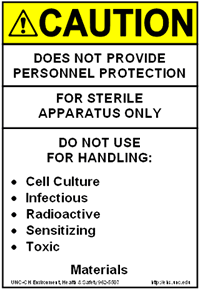 Clean Bench (3.5″ X 5″)
Clean Bench (3.5″ X 5″)- Horizontal and vertical laminar flow clean benches have sometimes been mistaken for biological safety cabinets. Clean benches provide product protection but no personnel protection. The horizonal flow clean bench discharges HEPA filtered air across the work surface onto the operator. The less common vertical flow clean bench discharges air downward from a HEPA filter above the work surface. The air flow leaves the work area through the front opening where the operator is located. With both versions of the clean bench, the operator could be exposed to contaminants generated by the work performed on the work surface. Clean benches can be used for assembly of sterile apparatus. They should not be used for handling cell cultures, drug formulations, radioactive nuclides, or biological hazards.
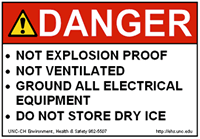 Cold Room (5″ X 3.5″)
Cold Room (5″ X 3.5″)- Cold rooms have closed air-circulation systems and re-circulate any leaks and escaped vapors within the chamber. The refrigeration coils in cold rooms are aluminum and subject to damage from corrosive atmospheres. The electrical systems are designed with vapor-proof lights and duplex outlets, but frequently are compromised by extension cords and plug strips. Cold rooms are not acceptable for storage of flammables, dry ice, or liquid chemicals. If these chemicals need to be refrigerated, they are to be stored in an approved refrigerator or freezer, rather than a cold box. A sign should be posted on the door as illustrated.
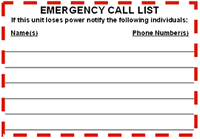 Emergency Call List (5″ X 3.5″)
Emergency Call List (5″ X 3.5″)- Write down names and phone number of people that need to be contacted if an emergency arises (e.g. power outage) for this piece of equipment.
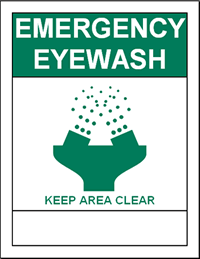 Emergency Eyewash (8.5″ X 11″)
Emergency Eyewash (8.5″ X 11″)- A green-on-white placard must be posted to designate emergency eyewash and shower facilities. You may laminate this sign or place it in a plastic sleeve before posting it.
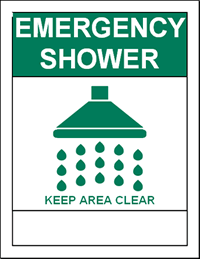 Emergency Shower (8.5″ X 11″)
Emergency Shower (8.5″ X 11″)- A green-on-white placard must be posted to designate emergency eyewash and shower facilities. You may laminate this sign or place it in a plastic sleeve before posting it.
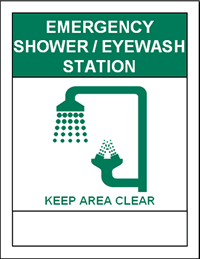 Emergency Shower/Eyewash (8.5″ X 11″)
Emergency Shower/Eyewash (8.5″ X 11″)- A green-on-white placard must be posted to designate emergency eyewash and shower facilities. You may laminate this sign or place it in a plastic sleeve before posting it.
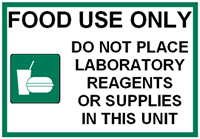 Food Use Only (5″ X 3.5″)
Food Use Only (5″ X 3.5″)- Laboratory refrigerators, ice chests, and cold rooms cannot be used for food storage. Laboratory microwave ovens cannot be used for food preparation. Separate equipment must be dedicated for that use and be prominently labeled.
 No Gloves (2.63″ X 1″)
No Gloves (2.63″ X 1″)- To avoid unintentionally spreading chemicals, remove your gloves before leaving the work area and before handling such things as telephones, doorknobs, writing instruments, laboratory notebooks, and textbooks.
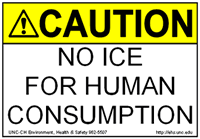 No Ice (5″ X 3.5″)
No Ice (5″ X 3.5″)- Signs should be applied to the doors of ice chests stating: NO ICE FOR HUMAN CONSUMPTION.
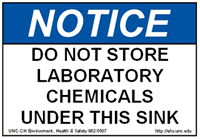 Store No Chemicals (5″ X 3.5″)
Store No Chemicals (5″ X 3.5″)- Cabinets under hoods and laboratory benches can be used for storage of chemicals. However, storage near or under sinks where there may be exposure to water is to be avoided.
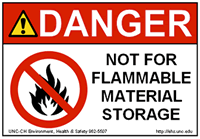 Store No Flammables (5″ X 3.5″)
Store No Flammables (5″ X 3.5″)- Flammable solvents that require storage at reduced temperature are to be stored only in refrigerators or freezers designed for the storage of flammable liquids. “Safety” refrigerators for flammable liquid storage and “explosion-proof” refrigerators are both acceptable. Ordinary household refrigerators are not to be used for the storage of flammable liquids because of interior arcing contacts. Because there is no venting of the interior spaces in refrigerators and freezers, all chemicals should have tightly sealed caps.
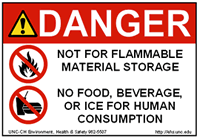 Store No Flammables/Food (5″ X 3.5″)
Store No Flammables/Food (5″ X 3.5″)- Flammable solvents that require storage at reduced temperature are to be stored only in refrigerators or freezers designed for the storage of flammable liquids. “Safety” refrigerators for flammable liquid storage and “explosion-proof” refrigerators are both acceptable. Ordinary household refrigerators are not to be used for the storage of flammable liquids because of interior arcing contacts. Because there is no venting of the interior spaces in refrigerators and freezers, all chemicals should have tightly sealed caps. Signs should be applied to the doors of chemical refrigerators stating: NO FOOD, BEVERAGE, OR ICE FOR HUMAN CONSUMPTION.”
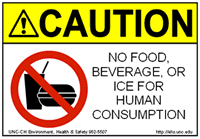 Store No Food (5″ X 3.5″)
Store No Food (5″ X 3.5″)- Laboratory refrigerators, ice chests, and cold rooms cannot be used for food storage. Signs should be applied to the doors of chemical refrigerators stating: “NO FOOD, BEVERAGE, OR ICE FOR HUMAN CONSUMPTION.”
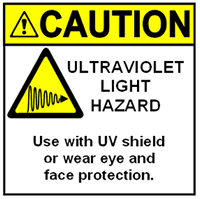 UV Hazard (2.75″ X 2.75″)
UV Hazard (2.75″ X 2.75″)- Ultra-violet light (UV) is defined as electromagnetic radiation in the spectral region between 180 and 400 nanometers (nm). Immediate or prolonged exposure to UV light can result in painful eye injury, skin burn, premature skin aging, or skin cancer. Individuals who work with or in areas where UV sources are used are at risk for UV exposure if the appropriate shielding and protective equipment are not used. Post on UV transilluminators.
 Emergency Eyewash Inspection Record Sheet (8.5″ X 11″)
Emergency Eyewash Inspection Record Sheet (8.5″ X 11″)- Used to document the monthly eyewash inspections. EHS recommends taping it to the inside of a cabinet door under the sink. It may also be posted on a wall or kept in a centralized folder. You may laminate this sign or place it in a plastic sleeve before posting it.
